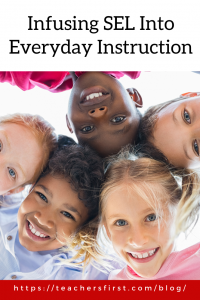It is critical to teach students strategies to deal with emotions and interact respectfully with peers. As a father of six, life can be crazy. My wife, also a teacher, enjoys our bedtime routine of reading aloud to our children. Recently, we read Lilly’s Purple Plastic Purse by Kevin Henkes. Lilly brings a purple plastic purse and its treasures to school. She is excited about sharing time, but her teacher, Mr. Slinger, confiscates her prized possessions. Lilly is furious, which leads to revenge and then to remorse. Finally, Lilly makes amends to culminate the story. A message from the story is to be patient and not interrupt. With a large family, that’s an important lesson for social interactions, especially at the dinner table when everyone is sharing about their day.
According to the Collaborative for Academic, Social, and Emotional Learning (CASEL), Social and Emotional Learning (SEL) is the process through which all young people and adults acquire and apply the knowledge, skills, and attitudes to develop healthy identities, manage emotions and achieve personal and collective goals, feel and show empathy for others, establish and maintain supportive relationships, and make responsible and caring decisions. In addition, SEL provides students the interpersonal skills necessary to safely learn about and manage their relationships with themselves and others. Skills acquired from SEL activities are beneficial to many facets of life. SEL is comprised of five core competencies to apply in the classroom, at home, and in students’ communities. These five core competencies are:
- Self-awareness – To recognize your emotions and how they impact your behavior, acknowledging your strengths and weaknesses to gain confidence in your abilities.
- Self-management – To take control and ownership of your thoughts, emotions, and actions in various situations, and setting and working toward goals.
- Social awareness – The ability to put yourself in the shoes of another person who may be from a different background or culture from the one you grew up with. To act with empathy and in an ethical manner within your home, school, and community.
- Relationship skills – The ability to build and maintain healthy relationships with people from a diverse range of backgrounds. This competency focuses on listening to and communicating with others, peacefully resolving conflict, and knowing when to ask for or offer help.
- Making responsible decisions – Choosing how to act or respond to a situation based on learned behaviors such as ethics, safety, weighing consequences, and the well-being of others, as well as yourself.
Given the impact of COVID-19 and the pressures of frantic pacing and high-stakes testing, the last thing a teacher needs right now is one more thing to implement in their classroom. However, teachers can infuse SEL concepts into their lessons. For example, educators can foster SEL in math class through growth mindset, perseverance, and risk-taking. Edutopia has outstanding ideas to integrate SEL into lessons. Here are some additional ideas to get you started:
- Journaling is a great activity to foster SEL skills in the classroom. For example, if you teach about inventors, you prompt students to write about what it might have been like to have lived during that time or made such an impactful discovery. Students use a tool like Wakelet (reviewed here) as a digital journal to write and organize their work.
- Providing a calm-down space in your classroom creates a safe environment where students can step away from emotional situations and calm down. This space might include a beanbag chair, comfy pillows, books, special lighting, fidget toys, noise-canceling headphones, calming images, and activities that allow students to help themselves practice self-management.
- Incorporating student engagement strategies like Write-Pair-Share, Jigsaw, or Sage and Scribe provides opportunities for students to build relationship skills. These collaborative strategies engage students in teamwork and communication and ensure they need one another to succeed. Think-pair-share would drive discussion in mathematics by asking students how they would solve a problem with more than one correct answer.
- Delegating class responsibilities encourages ownership in students. Taking responsibility increases student confidence while working towards a common goal helps students build relationships and community.
- Making time for daily check-ins increases self-awareness, one of the five core competencies of SEL, one that takes practice to hone. Consider alternating the time of day you ask students to reflect on their emotional and physical feelings. Keep in mind that this can be a quick activity like welcoming each student as they arrive and asking them how they feel.
- Providing peer feedback opportunities builds critical thinking and SEL skills. Students learn to be mindful of how their suggestions make others feel—how their tone and delivery can impact the conversation. Feedback exercises also afford students the chance to disagree and encourage one another respectfully.
- Incorporating Read Alouds supports both self and social awareness. They are great for all ages but especially younger students. Teachers positively model fluency, intonation, and expression—all things students may need assistance recognizing. Read Alouds can also help with listening skills and learning to discuss differing viewpoints.
SEL experiences in the classroom will better equip our students to confront challenges inside and outside school. So how are you integrating SEL into your instruction? We’d love to hear your strategies in the comments below!


